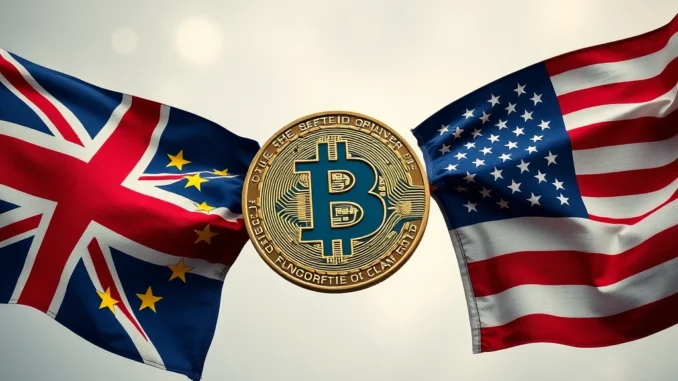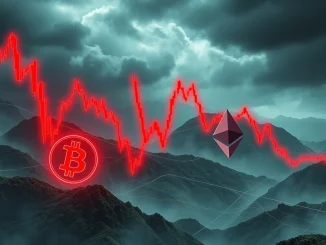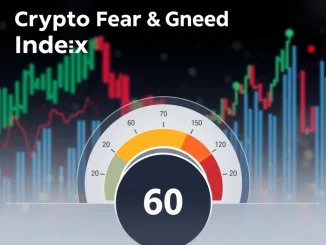
Hold onto your hats, crypto enthusiasts! The ongoing trade tensions between the European Union and the United States just took a dramatic turn, and it’s sending ripples through the Bitcoin market. With the EU slapping $28 billion in tariffs on U.S. goods, macroeconomic uncertainty is spiking, and analysts are waving red flags about potential Bitcoin volatility. Are we bracing for a wild ride?
Why Are EU-U.S. Tariffs Triggering Bitcoin Volatility?
The heart of the matter lies in the EU’s retaliatory tariffs. This move, a direct response to ongoing trade disputes, isn’t just about goods and taxes; it’s injecting a hefty dose of uncertainty into the global economic landscape. When traditional markets get jittery, it often spills over into the crypto sphere, and Bitcoin, despite its aspirations of being a safe haven, isn’t immune.
According to a recent Cointelegraph report, market watchers are particularly concerned. Bitcoin price dip predictions are circulating, with some analysts suggesting we might see a drop below the crucial $75,000 support level. Before you panic sell, however, it’s worth noting that these same analysts believe this dip could be a precursor to a potential rebound. Think of it as a possible short-term shakeout before the next leg up.
Expert Insights on Crypto Market Sentiment and Trade Tensions
Let’s dive into what the experts are saying:
- Marcin Kazmierczak, co-founder of RedStone, highlights the domino effect of counter-tariffs. He warns that these actions can escalate trade tensions, creating a ripple effect of negative crypto market sentiment. When traders and investors become wary of broader economic instability, risk assets like Bitcoin can face increased selling pressure.
- Aurelie Barthere, analyst at Nansen, points to a timeline. The ongoing tariff negotiations themselves might be enough to dampen risk appetite. She suggests this cautious approach could persist until early April, indicating a potentially choppy period for Bitcoin and other cryptocurrencies in the short term.
In essence, these experts are telling us that the EU-U.S. tariff dispute is adding fuel to the fire of macroeconomic uncertainty, and that fire is casting shadows over the crypto market, at least temporarily.
Beyond Tariffs: What Else Influences Bitcoin’s Price?
While the EU US tariffs are undoubtedly a factor right now, it’s crucial to remember that Bitcoin’s price is a complex interplay of numerous forces. Trade war impact is just one piece of the puzzle. Ryan Lee from Bitget offers a broader perspective, emphasizing that we need to look beyond immediate geopolitical events to understand Bitcoin’s long-term trajectory.
Here are some key elements that play a significant role in shaping Bitcoin’s future:
- Broader Economic Conditions: Inflation, interest rates, and overall economic growth all have a powerful influence on investor behavior and asset allocation. If the global economy faces headwinds, or if inflation remains stubbornly high, it can impact Bitcoin’s appeal as both a store of value and a speculative asset.
- Institutional Adoption: The increasing involvement of institutional investors is a game-changer for Bitcoin. Large players like hedge funds, corporations, and even sovereign wealth funds entering the Bitcoin space bring significant capital and validation. Continued institutional adoption is widely seen as a major bullish catalyst.
- Regulatory Shifts: The regulatory landscape for cryptocurrencies is constantly evolving. Developments in regulation, whether positive or negative, can have a profound impact on market sentiment and adoption. Clarity and favorable regulations could unlock further institutional investment and mainstream adoption, while restrictive measures could stifle growth.
Navigating Bitcoin Volatility in Uncertain Times
So, what does all this mean for you as a crypto investor or enthusiast? Here are a few actionable insights to consider:
- Stay Informed: Keep your finger on the pulse of global economic news, particularly developments in trade relations and macroeconomic indicators. Understanding the broader context is crucial for navigating potential market fluctuations.
- Manage Risk: Bitcoin volatility is inherent in the crypto market. Assess your risk tolerance and adjust your portfolio accordingly. Consider diversification and avoid investing more than you can afford to lose.
- Long-Term Perspective: While short-term volatility can be unsettling, remember that Bitcoin is still a relatively young asset class. Many investors maintain a long-term bullish outlook, focusing on the potential for future growth and adoption.
- Seek Expert Analysis: Pay attention to reputable analysts and market commentators who provide informed perspectives on market trends and potential price movements. However, always do your own research and make your own investment decisions.
The Bottom Line: Trade Winds and Crypto Waves
The EU-U.S. tariff dispute is a stark reminder that the cryptocurrency market doesn’t exist in a vacuum. Global economic events, trade tensions, and geopolitical shifts can all create waves of Bitcoin volatility. While these short-term uncertainties can be nerve-wracking, it’s essential to maintain a balanced perspective. The long-term narrative for Bitcoin remains compelling, driven by factors like institutional adoption and technological innovation. Navigating these turbulent times requires vigilance, informed decision-making, and a healthy dose of perspective. The crypto journey is rarely a smooth ride, but for those prepared for the bumps, the potential rewards remain significant.



